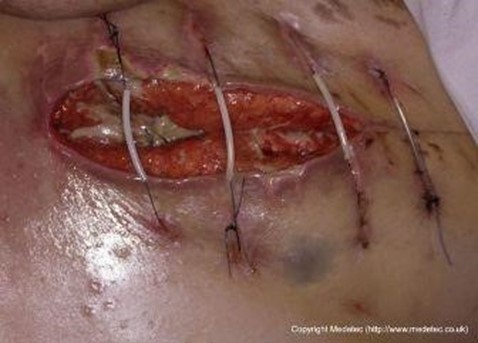A staff nurse is observing a newly licensed nurse suction a client’s tracheostomy.
Which of the following actions by the newly licensed nurse requires intervention by the staff nurse?
Inserts the catheter without applying suction.
Waits for 2 min between suctions.
Applies suction for 15 seconds.
Encourages the client to cough during suctioning
None
None
The Correct Answer is B
The correct answer is choice b. Waits for 2 min between suctions.
Choice A rationale:
Inserting the catheter without applying suction is correct. Suction should only be applied while withdrawing the catheter to prevent trauma to the tracheal mucosa.
Choice B rationale:
Waiting for 2 minutes between suctions is too long. The appropriate wait time is generally around 20-30 seconds to 1 minute between suction attempts to prevent hypoxia and allow the patient to recover.
Choice C rationale:
Applying suction for 15 seconds is within the recommended duration. Suctioning should not exceed 15 seconds to avoid causing hypoxia and trauma to the tracheal mucosa.
Choice D rationale:
Encouraging the client to cough during suctioning is appropriate. Coughing helps to mobilize secretions and can make suctioning more effective.
Nursing Test Bank
Naxlex Comprehensive Predictor Exams
Related Questions
Correct Answer is A
Explanation
- Answer and explanation.
The correct answer is choice A. Increased Hct.
Hct stands for hematocrit, which is the percentage of red blood cells (RBCs) in the blood.
A client who received 2 units of packed RBCs should have an increased Hct because they have more RBCs in their blood volume. The normal range for Hct is 38% to 50% for males and 36% to 44% for females.
Choice B is wrong because decreased Hgb means decreased hemoglobin, which is the protein that carries oxygen in the RBCs.
A client who received 2 units of packed RBCs should have an increased Hgb because they have more hemoglobin in their blood. The normal range for Hgb is 13.5 to 17.5 g/dL for males and 12 to 15.5 g/dL for females.
Choice C is wrong because increased platelets means increased thrombocytes, which are the cells that help with blood clotting.
A client who received 2 units of packed RBCs should not have an increased platelet count because they did not receive platelets in the transfusion. The normal range for platelets is 150,000 to 400,000/mm^3.
Choice D is wrong because decreased WBC count means decreased leukocytes, which are the cells that fight infection and inflammation.
A client who received 2 units of packed RBCs should not have a decreased WBC count because they did not receive WBCs in the transfusion. The normal range for WBC count is 4,500 to 11,000/mm^3.
Correct Answer is C
Explanation

Wound dehiscence can lead to infection, bleeding, and evisceration (protrusion of internal organs through the incision). The nurse should report this finding to the provider immediately and cover the wound with a sterile dressing moistened with sterile saline solution.
Choice A is wrong because mild swelling under the sutures near the incisional line is a normal finding in the early stages of wound healing. It does not indicate infection or dehiscence unless accompanied by other signs such as redness, warmth, pain, or purulent drainage.
Choice B is wrong because crusting of exudate on the incisional line is also a normal finding that indicates the formation of a scab.
A scab protects the wound from infection and helps it heal faster. The nurse should not remove the scab unless instructed by the provider.
Choice D is wrong because pink-tinged coloration on the incisional line is another normal finding that shows healthy granulation tissue.
Granulation tissue is new tissue that fills in the wound and helps it close. It is usually pink or red and moist.
The nurse should follow these general tips for postoperative abdominal incision care:
- Always wash your hands before and after touching your incisions.
- Inspect your incisions and wounds every day for signs your healthcare provider has told you are red flags or concerning.
- Look for any bleeding.
If the incisions start to bleed, apply direct and constant pressure to the incisions.
- Avoid wearing tight clothing that might rub on your incisions.
- Try not to scratch any itchy wounds.
- You can shower starting 48 hours after your operation but no scrubbing or soaking of the abdominal wounds in a tub.
- After the initial dressing from the operating room is removed, you can leave the wound open to air unless there is drainage or you feel more comfortable with soft gauze covering the wound.
- Surgical glue (Indermil) will fall off over a period of up to 2-3 weeks.
Do not put any topical ointments or lotions on the incisions.
- Do not rub over the incisions with a washcloth or towel.
- No tub baths, hot tubs, or swimming until evaluated at your clinic appointment.
Whether you are a student looking to ace your exams or a practicing nurse seeking to enhance your expertise , our nursing education contents will empower you with the confidence and competence to make a difference in the lives of patients and become a respected leader in the healthcare field.
Visit Naxlex, invest in your future and unlock endless possibilities with our unparalleled nursing education contents today
Report Wrong Answer on the Current Question
Do you disagree with the answer? If yes, what is your expected answer? Explain.
Kindly be descriptive with the issue you are facing.
